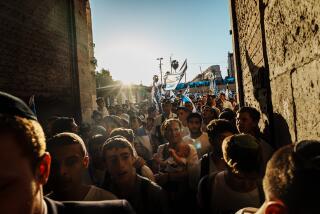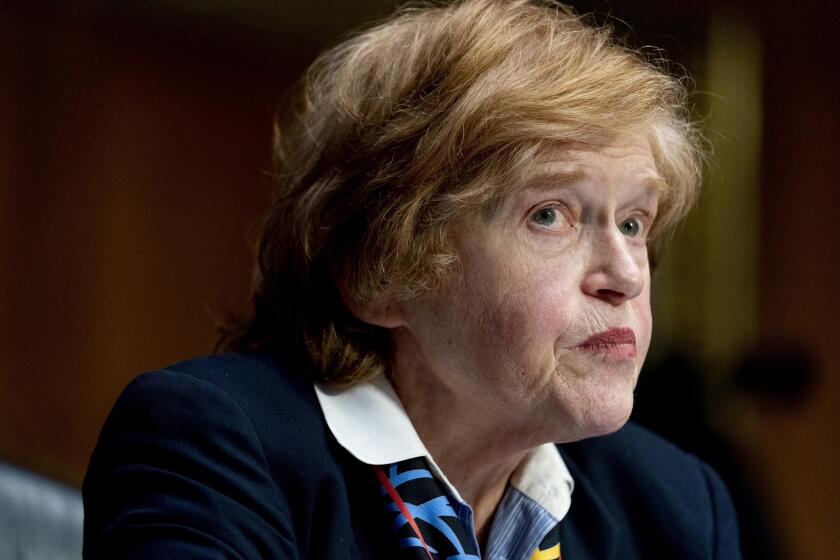Rare Harmony in Israel; Rage in Territories
Violence exploded again across the West Bank and Gaza Strip on Friday, even as Jews and Arabs inside Israel joined in a rare gesture of solidarity to protest state seizure of Arab lands.
While Israeli Arabs participated in the 26th observance of what is known as Land Day with peaceful marches, tree plantings and rallies, a Palestinian “day of rage” triggered clashes with soldiers in at least half a dozen West Bank and Gazan towns.
Soldiers shot to death six Palestinians and wounded more than 100 others, Palestinians said, as protesters burned Israeli flags and saluted suicide bombers who target Jews. There were gun battles in several cities, including divided Hebron, where Jewish settlers have rampaged repeatedly against Palestinians since a 10-month-old Jewish girl was shot to death this week.
Friday’s clashes capped a turbulent week that left the still-young government of Prime Minister Ariel Sharon, elected in February on a promise that he would restore security, warning Israelis that they face a long, costly struggle, and Palestinian Authority President Yasser Arafat vowing that his people will fight on.
As troops and protesters engaged in some of the worst fighting in weeks in the West Bank and Gaza, the orderly demonstrations by Arabs inside Israel offered both sides a rare glimmer of hope that coexistence is at least still imaginable.
Arab and Jewish Israelis who have struggled to keep alive the notion that they can live together had feared that violence inside Israel on Land Day could destroy their efforts.
In October, rioting in the West Bank and Gaza briefly spilled over into Israeli Arab towns and villages and badly damaged relations between the two communities. Israelis feared that Arabs, who make up nearly a fifth of the population, wanted to join the Palestinian revolt. Israeli Arabs felt betrayed by the state after police opened fire on rock-throwing protesters and killed 13 people.
Both communities heaved a collective sigh of relief when Friday’s Land Day observances passed quietly. Israeli Arab leaders said their community had proved that it can press its demands for full equality inside the Jewish state through peaceful protest.
“Today, the first stone has been laid for a new path in the relations between the state of Israel and its Arab citizens,” Salah Tarif, a minister without portfolio and the nation’s first Arab Cabinet member, said in a statement to reporters. “The Arab public and its leaders in Israel have proved that despite the difficulties and years of neglect from the government, they do not wish to harm the rule of law and order in the state that, after all, is their state.”
For the first time since Arabs began observing Land Day in 1976 to protest government confiscation of Arab property in the Galilee, Israel’s largest peace movement joined them. Several dozen Peace Now activists participated in the main demonstration in the Galilee town of Sakhnin. Several thousand Arabs, some bused in from other towns, marched down the main street to the high school playground, where they held a brief rally.
“We are here today partly because we were not here in October,” said Janet Aviad, one of the founders of Peace Now. “It was a hard decision, because we worried that radical forces might take over, but we wanted to strengthen those forces who believe in true equality. We may not agree with every slogan, but we agree with the general goal of achieving equality.”
Dozens of Jews from nearby towns also participated in the Sakhnin march, some for the first time. Marchers set out from the town’s cemetery, where they visited the graves of three demonstrators killed by security forces on the first Land Day and two killed in October. Some waved the red flag of the Democratic Front for Peace and Equality, an Arab-Jewish Communist party. Others waved the Palestinian flag, the green flag of the fundamentalist Islamic Movement or black flags of mourning.
Parents and grandparents clutched the hands of small children who trudged along the mile-long route in the heat, while teenagers, some wearing Che Guevara T-shirts and others garbed in the head scarves and full-length dresses of Islamic fundamentalists, chanted nationalist slogans and waved Palestinian flags. Jews dressed in jeans and T-shirts mingled with the crowd.
“I feel that they are our right hands,” said Mohammed abu Rayya of Sakhnin as he watched the Jews approvingly. Since October, he said, Jews have shied away from the town, and he hoped that the demonstrators were the vanguard of a return of shoppers and visitors.
“Our neighbors used to come here, sit down to eat and talk with us, but now it is empty,” he said. “I want them to come back.”
But some of the Arab marchers chanted, “We tell you frankly, we don’t want to see Zionists!” and “Revenge! Revenge! Oh you battalions of Qassam!” a reference to a fundamentalist movement in the West Bank that has carried out suicide bombings. One man burned an Israeli flag during the rally, and some protesters booed when Sakhnin’s mayor thanked Jews for coming.
In October, when demonstrators headed on the same road toward a Jewish-owned industrial park just outside town and hurled stones and bottles at police, two protesters were killed. This time, protesters marched away from Jewish communities, and there were no police to be seen.
Israel’s police commander, Shlomo Aharonishki, told reporters that order was maintained because the police and leaders of the Arab community had engaged in an intensive dialogue in the run-up to Land Day and police had learned lessons from the October disturbances. A state-appointed commission is investigating the deaths of the 13 demonstrators in October, which Arabs have blamed on a heavy-handed police response.
But the only dialogue apparent between Israel and the Palestinians is one of strikes and counterstrikes in a seemingly endless cycle of violence that has claimed more than 400 lives since September.
Demonstrators in Ramallah, where Israeli helicopter gunships targeted Arafat’s presidential guard this week, marched through downtown after noon prayers and burned representations of a Jewish settlement and of two Israeli buses. They set off firecrackers to simulate the explosions that have terrorized Israeli cities in recent weeks.
There were fierce clashes with Israeli forces on the outskirts of town, with troops firing rubber-coated bullets, tear gas and live ammunition at stone-throwers and, later, using heavy machine guns when Palestinian gunmen opened fire on them. One Palestinian was shot and killed in the fighting.
Doctors at Al Rahme maternity hospital in Ramallah said that their institution came under fire and that three women who gave birth during the morning had to be evacuated. An Israeli army spokeswoman said the hospital was not targeted.
In Jerusalem’s Old City, where this uprising began six months ago, hundreds of Palestinians finished prayers at Al Aqsa mosque and then threw stones at Jewish worshipers praying at the Western Wall, which lies below the raised compound. Police evacuated the Jews and skirmished with the Palestinians in the narrow, cobbled streets of the walled Old City, firing tear gas and rubber-coated bullets.
Also in Jerusalem, a few rounds were fired from Palestinian-controlled territory at the neighborhood of Gilo, built on land Israel captured from Jordan during the 1967 Middle East War.
In Gaza, the radical Islamic movement Hamas held a massive rally, and 30 gunmen from Arafat’s Fatah faction led a march.
The bloodiest clash was in Nablus, where five Palestinians were shot dead and about 50 were wounded when a crowd of thousands marched down the main road out of town to an Israeli checkpoint.
Palestinians said Israeli army snipers fired on the marchers from the hills. An army spokeswoman said Israeli forces used “crowd dispersal measures” against rioters who she said threw stones, Molotov cocktails and iron bars at troops. She said she could not confirm that snipers shot at protesters.
*
Curtius reported from Sakhnin and Wilkinson from Ramallah.
More to Read
Sign up for Essential California
The most important California stories and recommendations in your inbox every morning.
You may occasionally receive promotional content from the Los Angeles Times.







